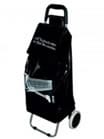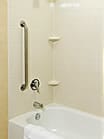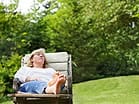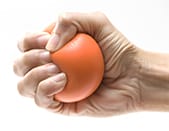Protect your joints

Do not force on a joint in an osteoarthritic flare-up.
If you are suffering with a weight-bearing joint (hip, knee, ankle) it is very important to rest it. It will enable your cartilage to repair. Hence, for example, you could use crutches, shopping carts or trolleys, so as not to increase the weight carried by your joints.
However, the period of rest should not be too long. You must maintain your muscles. So when you are not suffering any longer, you must maintain the flexibility of your joints by stretching exercises and protect them by maintaining your muscles. Swimming and keep-fit mat exercises are recommended but anything goes as long as the period of standing is not excessive.
Do not "stress" your body

Take time to take a break after each effort.
Use your back, your arms and your legs in order to avoid forcing on your muscles and joints.
Use useful devices such as a shopping cart to transport your groceries. A grab handle on the wall of the shower will allow you to get in and out the bathtub more easily.
Do not stay in the same position for too long
Feel free to use a cane to relieve your joints when you are on the go.
Exercise

Physical exercise in a person with joints affected by osteoarthritis is useful and even highly recommended.
Physical activity (outside of inflammatory flare-ups) enables relieving pain, preventing joint damage, and losing weight in the event of excess weight and reducing the burden weighing on the joints.
Physical activity strengthens the muscles and tendons, allowing the body to better withstand shocks to the jolts caused by exercising. In addition, in case of a violent impact (a fall for example), a joint surrounded by healthy toned muscle is always better protected.
What types of exercises can be done when one has osteoarthritis?
- Some simple exercises help relieve stiffness and maintain joint mobility (e.g. range of motion exercises for the shoulder by drawing a circle with your arm, without forcing).
- Other exercises help maintain flexibility of tendons and muscle strength (e.g. stretching exercises, swimming, walking, aerobics, cycling, and even some exercises against resistance using elastic bands or quite light weights).
- In all instances, it is necessary to consult your doctor before starting an exercise routine.
See some recommended exercises
Consult our exercices sheets of maintenance movements
What types of exercises should you avoid when you have osteoarthritis?
- It is prudent to avoid an activity that could further traumatize an already vulnerable joint, but it is possible to pursue a sport on a regular basis provided you practise it in a reasonable manner and ensure you use the correct technique for your movements and you use good quality equipment.
- It is best to avoid sudden changes in the intensity and length of your exercises as this is a common cause of joint injuries. It is also essential to begin and end your session of physical activity gradually. A good warm-up before starting your exercises and gently stopping are recommended.
- Sports that cause repeated injuries can accelerate the wear of the cartilage when practised intensively: gymnastics, hockey or classical dance.
In the event of back pain, you should avoid activities such as skiing or horseback riding.
Relax

Relaxing the muscles surrounding the inflamed joint relieves the pain.
How do you relax?
- Concentrate on breathing exercises and rediscover the sensations of your body.
- There are tapes and CDs for relaxation.
- Relax by taking the time to meditate.
- Create an inner world of well-being by imagining enjoyable activities (beach, diving, etc.)
Applying heat may also help relax muscles and relieve joint pain. Applying cold helps to reduce pain and swelling during inflammatory periods.
Watch your diet
If you suffer from a joint like the hip or knee, dieting can be beneficial to reduce the weight carried by your joints. But before making such a decision you should talk to your doctor about it. He or she can then advise you on the type of diet to set up and accompany you in this initiative.
Be an active player in your care

You have a major role to play in monitoring your osteoarthritis.
It is very important that you:
- do not hesitate to go and see your doctor if an aspect of your self evaluation shows a change for the worse;
- will go for an X-ray which, as you will remember, is used for monitoring osteoarthritis in a concrete way. The frequency of radiological monitoring is guided by your symptoms;
- follow your prescribed treatment correctly. It is very useful to know the name and dosage of the medication prescribed by your doctor.



















